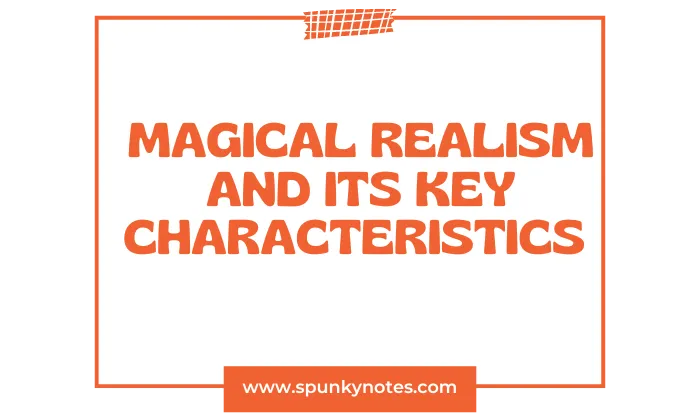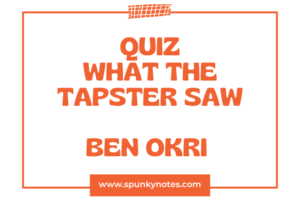

Estimated Reading Time: 6 min
Q. What is magical realism? Discuss the characteristics of magical realism.
Magical realism is a literary genre in which magical elements blend with the real world. It is presented straightforwardly, placing the “real” and the “fantastic” in the same stream of thought.
Magic realism originates in various cultural and literary traditions. However, it gained prominence in Latin American literature in the mid-20th century.
The German art critic Franz Roh coined the term “magic realism” in the 1920s. However, the Cuban writer Alejo Carpentier later popularized it and associated it with literature.
Key characteristics of magical realism
- Realistic Setting
- Authorial Reticence
- Presence of the Extraordinary
- Time Distortion
- Hybridity
- Metafiction
- Political Critique
1- Realistic Setting
The realistic setting of magical realism grounds the reader in a familiar world, often indistinguishable from our own, where life’s daily ins and outs occur as expected.
This setting acts as a stage for introducing magical or fantastical elements that interrupt and challenge the world’s perceived normality.
The magical events are not situated in a far-off land of fantasy but within the confines of our recognizable reality. This fusion of the mundane with the magical creates a jarring juxtaposition that can highlight societal issues.
2- Authorial Reticence: The Unexplained as Normal
Magical realism distinguishes itself through authorial reticence—the author intentionally doesn’t explain or justify the magical events in the story. This withholding of information enhances the magical quality of these events, making them seem more mysterious and profound.
The lack of explanation, however, does not lead to a sense of disbelief or confusion. Instead, magic is treated as normal and an integral part of life, facilitating a seamless fusion of the real and the magical.
3- Presence of the Extraordinary
In magical realism, the extraordinary becomes ordinary. Supernatural events are depicted as routine occurrences, accepted and unchallenged by the characters.
This casual acceptance normalizes the magic. It incorporates it into the fabric of daily life and blurs the boundaries between the real and the unreal.
This magical realism aspect also encourages readers to question their perception of reality and consider magic’s possibility in their mundane lives.
4- Time Distortion: The Fluidity of Time
Magical realism often employs time distortion, presenting time as cyclical, static, or eternal rather than linear. This flexible perception of time can create a dreamlike or surreal atmosphere.
It further enhances the narrative’s magical quality. It also allows for the coexistence and intermingling of different periods, enabling the exploration of themes like history, memory, and fate.
5- Hybridity: The Blurring of Boundaries
Hybridity in magical realism involves the blending of opposites or contradictions. This could encompass various dichotomies, such as life and death, past and present, or natural and supernatural.
Magical realism challenges traditional boundaries and offers a more fluid, interconnected view of reality by blurring opposing concepts.
6- Metafiction: The Story within the Story
Metafiction is a form of storytelling in which the narrative self-consciously and systematically draws attention to its status as a work of art. In other words, it’s when a story acknowledges that it’s a story.
Authors can accomplish this in many ways, such as directly addressing the reader and incorporating the writing process into the narrative. In the context of magical realism, metafiction can enhance the blending of the real and the fantastical.
By acknowledging its artificiality, the narrative can make the reader more aware of how it’s constructing reality. It can create a sense of distance or irony, simultaneously making the magical elements seem more surreal and believable.
7- Political Critique
Writers frequently use magical realism as a tool for political critique. By incorporating magical elements into a realistic setting, authors can express complex political or social issues in a more symbolic, metaphorical way.
The unbelievable events can serve as metaphors for real-world issues, illuminating them in a new light and encouraging readers to view them differently. This use of allegory can also make the critique more digestible and engaging.
In conclusion, magical realism is not just a literary genre but a narrative strategy. It uses the fusion of the real and the magical to challenge our perceptions of reality, blur boundaries, and provide a social and political critique.
By incorporating magical elements into a realistic setting, authors can explore complex themes and issues in a unique and engaging way.
Using authorial reticence, time distortion, hybridity, and metafiction, writers can craft a story that blurs the line between familiar and unfamiliar, real and surreal, mundane and magical.
The effectiveness of magical realism lies in its ability to defamiliarize the familiar. It makes the ordinary seem extraordinary. It also reminds us that reality is not objective but subjective and fluid. Our perceptions, beliefs, and stories shape it.
5 Magical Realism Novels You Should Read
1- One Hundred Years of Solitude, written by Gabriel Garcia Marquez
Although originally written in Spanish, this novel is a seminal work in magical realism and profoundly influences literature worldwide. It tells the story of the Buendía family and chronicles several generations in the mythical town of Macondo.
2- Beloved by Toni Morrison
This novel incorporates elements of magical realism in its exploration of the African American experience of the Civil War. The narrative is haunted by the spectre of a child, Beloved, whose presence is both metaphorical and eerily literal.
3- Life of Pi by Yann Martel
In this mesmerizing novel, a young boy survives a shipwreck and shares a boat with a Bengal tiger, blurring reality and fantasy in a captivating blend of magical realism.
4- The Master and Margarita by Mikhail Bulgakov
Though written in Russian, this novel’s English translations have gained a global following. The narrative intertwines two settings: Moscow in the 1930s, where Satan wreaks havoc, and ancient Jerusalem, presenting an uncanny amalgamation of the extraordinary and the everyday.
5- The Ocean at the End of the Lane, written by Neil Gaiman
This novel melds reality and fantasy as it recounts a man’s childhood memories of a mysterious supernatural event and the three peculiar women who live down the lane. Gaiman is known for infusing his work with elements of magical realism.
5 Magical Realism Short Stories You Should Read
1- What You Pawn I Will Redeem by Sherman Alexie
2- A Very Old Man with Enormous Wings by Gabriel García Márquez
3- The Library of Babel by Jorge Luis Borges
4- What The Tapster Saw by Ben Okri
5- The Red Shoes by Hans Christian Andersen


